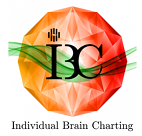 The aim of the Individual Brain Charting (IBC) project is to collect a multi-task, high spatial resolution functional MRI dataset, in order to establish a comprehensive atlas of brain responses to different stimuli. The data, acquired from a cohort of twelve participants subjected to a wide range of behavioral tasks, provide a precise individual mapping of the underlying cognitive functions, free from variability between acquisition sites, but accounting for variability between individuals. The open-access data set is accompanied by high-resolution anatomical and diffusion images for fine anatomical characterization of these brains.
The aim of the Individual Brain Charting (IBC) project is to collect a multi-task, high spatial resolution functional MRI dataset, in order to establish a comprehensive atlas of brain responses to different stimuli. The data, acquired from a cohort of twelve participants subjected to a wide range of behavioral tasks, provide a precise individual mapping of the underlying cognitive functions, free from variability between acquisition sites, but accounting for variability between individuals. The open-access data set is accompanied by high-resolution anatomical and diffusion images for fine anatomical characterization of these brains.
In a first publication in 2018, the researchers presented the initial version of an IBC project dataset, which included a dozen tasks (IBC 1).
In a 2nd paper in 2020, the consortium of researchers studied the feasibility of individually mapping the cognitive components underlying the tasks, and thus individualized six regions of interest in the linguistic network and established their cognitive profile (IBC 2).
In this third publication, the researchers provide a detailed description, as well as technical validation, of naturalistic tasks (such as watching a film) or tasks built on the question/answer model, in order to discover the structures and activation of the networks of the visual, auditory and language systems in real-life situations. Their approach is based on the Fast Shared Response Model (FastSRM), an algorithm that enables fast and simple large-scale analysis of fMRI data acquired during naturalistic stimulation. They thus added six new tasks to the IBC, including four retinotopic tasks.
The results show that cognitive networks of functional data collected from naturalistic paradigms can be extracted using FastSRM, an unsupervised data-driven method, without explicitly modeling stimulus features.
The authors point out that IBC is an open-access resource: sources, derived imaging data and metadata are available in public repositories.
Contacts : Bertrand Thirion (bertrand.thirion@inria.fr / bertrand.thirion@cea.fr) ; Lucie Hertz-Pannier (lucie.hertz-pannier@cea.fr)
- The naturalistic approach aims to understand how the brain functions “in its natural state". It stems from the need to go beyond the simplistic experimental situations often used in neuroscience, in order to apprehend behavior in real or natural conditions and identify the neural mechanisms underlying it.
- Retinotopy refers to the spatial organization of neuronal responses to visual stimuli.